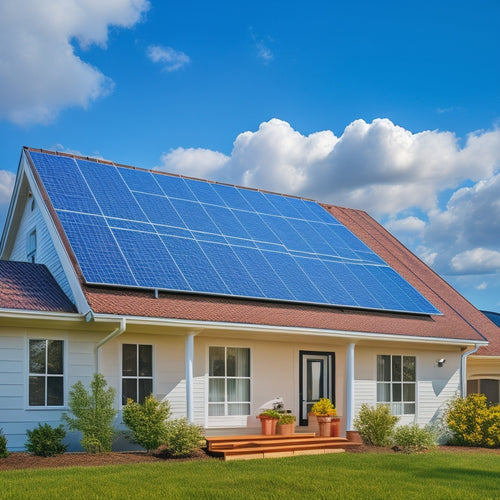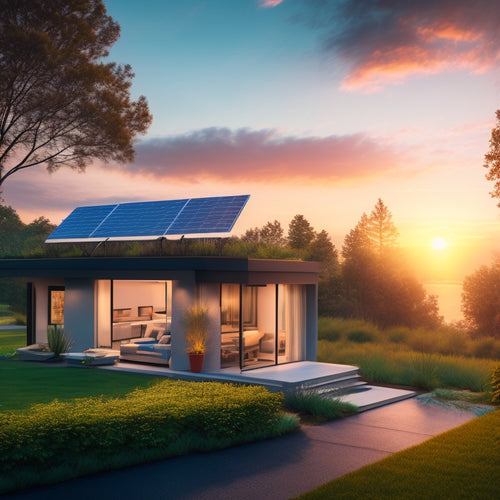
Off Grid Solar Set Up
Share
You're designing an off-grid solar setup to break free from traditional energy sources, and this all-encompassing system will enable you to generate, store, and manage your own renewable energy. Key components include solar panels, battery storage, and inverter technology, which work together to provide autonomy and sustainability. To guarantee peak performance, you'll need to evaluate your energy requirements, choosing the right solar panel type, deep cycle batteries, and MPPT charge controllers. By considering your power needs and appliance ratings, you can create a reliable and efficient system that minimizes your carbon footprint. Now, uncover how to tailor your setup for maximum energy independence.
The Essentials
- Off-grid solar setups enable autonomy from traditional energy sources, providing a sustainable alternative to fossil fuels.
- Key components of off-grid systems include solar panels, battery storage, and inverter technology, requiring regular maintenance for optimal performance.
- Evaluation of energy requirements is crucial for off-grid success, involving calculation of daily energy needs and appliance power ratings.
- MPPT charge controllers optimize energy collection from solar panels, capturing up to 30% more energy than traditional PWM controllers.
- Accurate evaluation of power requirements and appliance efficiency ratings lead to a reliable and sustainable off-grid power source.
Energy Independence Matters Most
You're likely considering an off-grid solar set up because you want to break free from the grid and enjoy energy independence. This means having a renewable energy future where you're not reliant on fossil fuels, and instead, generate your own clean energy.
Many homeowners and businesses struggle with the complexity and uncertainty of designing and installing a reliable off-grid solar system that meets their unique energy needs, but with the right solution, you can overcome these challenges renewable energy solutions.
Renewable Energy Future
As the world shifts towards a more sustainable tomorrow, a renewable energy future takes center stage, driven by the pressing need for energy independence.
You're likely aware that solar technology has come a long way, making sustainable living more accessible than ever. With advancements in energy storage, off-grid systems are becoming increasingly efficient, allowing you to break free from the grid.
By opting for an off-grid solar kit, you can solve three major problems that come with relying on the grid or generators: high energy costs, noisy and polluting fuel-based systems, and limited access to power in remote areas.
Solar innovations are continually pushing the boundaries of what's possible, reducing environmental impact and creating opportunities for a greener future.
As you consider your own renewable energy future, it's important to stay informed about future trends in green energy. Power autonomy is within reach, and community solar initiatives are making it easier for individuals to come together and invest in a sustainable future.
By embracing renewable energy, you're not only reducing your carbon footprint but also taking a significant step towards energy independence.
With the right off-grid solar setup, you can enjoy the freedom and security that comes with generating your own clean energy.
Energy Self Sufficiency
Energy independence is the ultimate goal of renewable energy systems, and off-grid solar setups can get you there. You're not bound by the grid, and you're in control of your energy production and consumption. To achieve energy self-sufficiency, you need to evaluate several key factors.
| Component | Key Considerations |
|---|---|
| Solar Panels | Choose the right type (monocrystalline, polycrystalline, thin-film) for your climate and budget |
| Battery Storage | Select the right option (lead-acid, lithium-ion, flow batteries) for your energy needs and budget |
| Inverter Technology | confirm compatibility with your solar panel and battery storage systems |
| Energy Monitoring | Install a system to track your energy production and consumption in real-time |
| Maintenance Practices | Regularly inspect and maintain your system to guarantee peak performance |
When going off-grid, you'll need to assess your site's energy requirements, evaluate the installation process, and weigh the cost considerations. While there are benefits to connecting to the grid, you'll need to analyze if the benefits outweigh the costs. By carefully evaluating these factors, you'll be well on your way to achieving energy self-sufficiency.
Reduced Carbon Footprint Guarantee
As you shift to an off-grid solar set up, you'll greatly reduce your carbon emission reduction, making a substantial impact on the environment.
By utilizing solar energy, you're switching to an eco-friendly energy source that produces no emissions, contributing to a cleaner and healthier planet.
This setup is ideal for remote homes, RVs, or cabins, providing independence from the grid off grid electricity.
With the ability to track and measure your renewable energy production, you'll be able to monitor your carbon footprint reduction, ensuring a guilt-free energy consumption.
Carbon Emission Reduction
You can greatly reduce your carbon footprint by utilizing renewable energy from the sun. By switching to an off-grid solar set up, you're not only reducing your reliance on fossil fuels but also contributing to a cleaner environment. This shift towards sustainable living is vital in the modern era, where climate change is a pressing concern.
To put things into context, here's a comparison of carbon emissions from traditional energy sources versus solar energy:
| Energy Source | Carbon Emissions (kg/kWh) |
| Fossil Fuels | 1.05 |
| Natural Gas | 0.45 |
| Solar Energy | 0.03 |
As you can see, solar energy produces considerably less carbon emissions compared to traditional energy sources. By adopting an off-grid solar set up, you're taking a significant step towards reducing your carbon footprint. Additionally, you can investigate carbon offset strategies to further minimize your impact on the environment. By making this switch, you're not only contributing to a cleaner environment but also gaining independence from the grid and enjoying the freedom that comes with it.
Eco-Friendly Energy Source
With solar energy producing a mere 0.03 kg/kWh of carbon emissions, it's clear that an off-grid solar set up is an eco-friendly energy source that assures a reduced carbon footprint.
You'll be utilizing the power of the sun to generate electricity, greatly minimizing your reliance on fossil fuels and lowering your environmental impact.
When it comes to choosing the right solar panel types for your off-grid setup, you'll want to take into account factors like efficiency, durability, and cost.
Monocrystalline silicon panels offer high efficiency rates, while polycrystalline panels provide a more affordable option.
Thin-film panels, on the other hand, are lightweight and flexible, making them ideal for portable systems.
To guarantee a steady supply of power, you'll need a reliable battery storage system.
Deep cycle batteries, like lead-acid or lithium-ion, are designed to store excess energy generated by your solar panels during the day for use at night or during periods of low sunlight.
MPPT Charge Controller Benefits
When you're setting up an off-grid solar system, you want to maximize energy harvesting and guarantee reliable power management, especially when using high-performance off-grid solar power inverters for renewable energy systems.
By considering top off-grid inverters such as Renogy, Victron, Outback, Magnum Energy, and Xantrex renewable energy solutions, you'll be able to produce reliable AC power anywhere without relying on the grid or noisy generators.
That's where an MPPT charge controller comes in, allowing you to capture more energy from your solar panels and regulate power flow to your batteries.
Efficient Energy Harvesting
A essential component of an off-grid solar setup is the charge controller, which plays an important role in ensuring efficient energy collection.
You'll want to capture as much power as possible from your solar panel technology to charge your energy storage solutions. That's where a Maximum Power Point Tracking (MPPT) charge controller comes in. This advanced technology allows your system to optimize energy collection by identifying the maximum power point of your solar panels and adjusting the charge flow accordingly.
With an MPPT charge controller, you can expect up to 30% more energy collection compared to traditional PWM controllers. This means more power for your off-grid lifestyle, allowing you to enjoy the freedom and independence you desire.
By maximizing energy production, you'll reduce your reliance on fossil fuels and minimize your carbon footprint. Plus, MPPT controllers often come with advanced features like monitoring and tracking capabilities, giving you greater control over your system's performance.
Reliable Power Management
Your off-grid solar setup relies on the MPPT charge controller to manage power efficiently, and its benefits extend far beyond just energy collection. This device optimizes energy harvesting by tracking the maximum power point of your solar panels, ensuring you get the most out of your array.
With an MPPT charge controller, you'll enjoy improved battery storage and inverter selection, as it regulates the flow of energy to your batteries and inverter. You'll also have real-time energy monitoring, allowing you to keep tabs on your system's performance and make adjustments as needed.
Additionally, load management becomes more precise, and system scalability is enhanced, making it easier to add or remove components as your energy needs change. Proper maintenance practices are also simplified, and grid backup becomes more reliable.
Assess Your Power Requirements
You'll need to determine your daily energy needs to size your off-grid solar setup correctly. This involves calculating the total power consumption of all your appliances, which requires knowing their individual power ratings.
As you plan your off-grid power system, consider exploring sustainable energy systems that cater to your specific needs. Start by making a list of all the appliances you plan to run, along with their wattage and usage hours per day.
Daily Energy Needs
Energy autonomy begins with a thorough understanding of daily energy needs. To determine your power requirements, you'll need to calculate your total daily energy consumption in watt-hours (Wh). This involves identifying the devices you want to power, their respective energy ratings, and the number of hours they'll be used daily.
Consider the type and number of solar panels needed to meet your energy demands, as well as the battery storage capacity required to guarantee a stable power supply during periods of low sunlight or at night.
You'll want to factor in appliances with varying power consumption, such as LED lights, laptops, and refrigerators. Be sure to also consider the efficiency of your system, considering factors like inverter losses and cable resistances.
By accurately evaluating your daily energy needs, you can design an off-grid solar set up that meets your specific requirements, assuring a reliable and sustainable source of power.
With the right combination of solar panel types and battery storage, you'll be well on your way to achieving energy independence.
Appliance Power Ratings
To accurately assess your power requirements, start by gathering the power ratings of all appliances you plan to run on your off-grid solar setup. You'll need to know the wattage and voltage of each appliance to calculate your total power consumption.
Check the manufacturer's specifications or the appliance's nameplate for this information. Be sure to include both continuous and surge ratings, as these can greatly impact your overall power needs.
Next, consider the appliance efficiency of each device. Look for appliances with high efficiency ratings, as these will consume less power for the same task.
For example, an LED light bulb is much more efficient than an incandescent bulb, using considerably less power to produce the same amount of light.
Higher Efficiency Energy Harvesting
You'll want to optimize your off-grid solar setup with Max Power Point Tracking (MPPT) to guarantee you're harvesting the maximum amount of energy from your solar panels.
MPPT technology continuously monitors and adjusts the voltage and current output of your panels to match the maximum power point, resulting in up to 30% more energy harvested.
Max Power Point Tracking
Optimizing your off-grid solar setup's energy harvesting capabilities hinges on employing Max Power Point Tracking (MPPT), a sophisticated technology that guarantees your system extracts the maximum power from your solar panels.
By incorporating MPPT into your system, you'll be able to utilize the full potential of your solar array, even in less-than-ideal conditions.
MPPT works by continuously monitoring the voltage and current output of your solar panels, adjusting the power regulation to guarantee maximum energy optimization.
This advanced tracking system allows your setup to adapt to changing environmental conditions, such as cloud cover or temperature fluctuations, assuring you get the most out of your solar technology.
With MPPT, you can expect increased solar efficiency, reduced energy waste, and a more reliable grid disconnect.
Frequently Asked Questions
Can I Use Any Type of Battery for Off-Grid Solar Systems?
You can't use just any battery for energy storage; you need ones designed for deep-cycle, long-duration discharge, like lead-acid, lithium-ion, or nickel-cadmium, which can handle the daily charge-discharge cycles in your off-grid solar setup.
How Often Should I Clean My Solar Panels for Maximum Efficiency?
You should clean your solar panels every 6-12 months to maintain maximum efficiency; regular panel cleaning is essential, as dust and debris can reduce energy output by up to 25%, so prioritize this simple efficiency tip.
Are Off-Grid Solar Systems Suitable for Small Apartments or Homes?
You think you need a sprawling backyard to utilize the sun's power? Think again! You can tap into apartment energy freedom with a compact solar system size that's perfectly suited for small homes, giving you independence from the grid.
Can I Add More Panels to My Existing Off-Grid Solar Setup?
When expanding your system, you'll need to guarantee panel compatibility to avoid efficiency losses. You're free to add more panels, but carefully assess your existing setup's capacity for system expansion to maintain ideal performance.
Do Off-Grid Solar Systems Require Regular Maintenance or Checks?
You'll want to prioritize regular maintenance to guarantee system longevity; creating a maintenance schedule helps you stay on top of checks, assuring your independence from the grid and uninterrupted power supply.
Final Thoughts
Savoring sweet solar serenity, you've successfully sidestepped the grid's grasp. Your off-grid solar setup seamlessly synchronizes sustainability and self-sufficiency. With MPPT expertise, you're maximizing energy extraction and minimizing your carbon footprint. By precisely pinpointing your power needs, you've paved the path to perpetually powered freedom. Bask in the brilliance of your bespoke solar solution, where autonomy and eco-awareness align in perfect harmony.
Related Posts
-

Cost of Solar Panel Installation
You can expect to pay between $15,000 and $30,000 or more for a typical solar panel installation, depending on the sy...
-

The Future of Residential Energy Storage
The future of residential energy storage looks promising and cost-effective for you. With lithium-ion battery prices ...
-

Top Solar Powered Camping Fans for Camping Enthusiasts
If you're a camping enthusiast, a solar-powered fan can be a transformative element for your outdoor experience. Thes...


